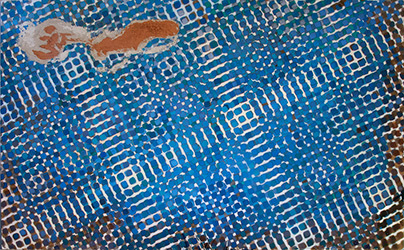MONOCHROMES & ANICONIC FRESCO PAINTINGS
|

" The transformative Power of Art" Exhibition, United Nations Headquarters, New York. June 2015 |
| 
A Carmine to circulate the blood happily
Lime mortar, pigments on curved and shaped panel
cm 185 x 185 x 5
2008 |

A cobalt blue for happiness
Lime mortar, pigments on curved and shaped panel
cm 185 x 185 x 5
2009 |
|
| |

A Green Moss to calm the restlessness
Lime mortar, pigments on curved and shaped panel
cm 105 x 105 x 4
2012 |

A pure White, purity
Lime mortar, pigments on curved and shaped panel
cm 185 x 185 x 5
2017 |
The very act of painting have a peculiar significance in monochrome. The themes of narrative and representation are removed, the focus is shifted to the real elements of painting, the support and its shape, tint and the way of building it up by the relationship of contiguity to the support. |
|

Grids and Mono
Lime mortar, pigments on curved and shaped panel
Four panels each: cm 155 x 100 x 5
2015 |

Triple monochrome
Lime mortar, pigments on curved and shaped panel
three panels each cm 90 x 210 x 5
2018 |
The absence of figures, history and narrative in monochrome paintings is intended to provoke the mind of the observer at first to generate What-you-see, then for wandering into a territory that poet Giacomo Leopardi defined as the place where “ the soul imagines what it has not seen "and, after wandering at will, the soul accepts the invitation of the monochrome and takes rest in the here and now of the unknown that surrounds it. |
|

Cobalt blue fragment
Lime mortar, pigments on canniccio
cm 80 x 110
2013 |

Siena Fragment
Lime mortar, pigments on canniccio
cm 80 x 110
2013 |
|
| > |
Structure and Form
- Analytical Fresco Paintings-
In modern physics, the universe is thus experienced as a dynamic, inseparable whole which always includes the observer in an essential way.
(Fritjof Capra, The Tao of Physics, 1975) |

" Quietly walking through Nigredo"
" The transformative Power of Art" Exhibition, United Nations Headquarters, New York. June 2015 |
|

Crossroads of strips and squares
Lime mortar and pigments on
wooden panel
cm 150 x 150 x 3
|

Sukha-vipaka data stream
Fresco on curved and shaped wooden panel
Two panels each:
cm 155 x 155 x 15 |
|

|

Quietly walking through Nigredo
Fresco and pigments on curved wooden panel
cm 155 x 210 x 15
--1996- |

Approaching Storm
Fresco and pigments on curved wooden panel
cm 155 x 210 x 15.
1996 |
 |
In the temporal dimension, the grid is an emblem of Contemporary by being just that: the form that is ubiquitous, combined to precipitate the grid into a position of aesthetic preeminence. But once the grid appears it seems quite resistant to change, by depriving its world of development, one is obviously not depriving it of quality.
There is no necessary connection between good art and change, no matter how conditioned we may be to think that there is. Indeed, as we have a more and more extended experience of the grid, we have discovered its capacity to serve as a paradigm or model for the antidevelopmental, the antinarrative, the antihistorical.
By "discovering" the grid, FR.. landed in a place that was out of reach of everything that went before. Which is to say, he landed in the present.
.
|
|

Shere Khan
Fresco with lime plaster and natural pigments
on wooden curved panel.
Cm. 114 x 152 = 45 x 60 inches |

Shah-un-Dhan
Fresco with lime plaster and natural pigments
on wooden curved panel.
Cm. 114 x 152 = 45 x 60 inches |

Mental landscape reflex
Fresco on curved and shaped wooden panel.
cm. 90x120 |

Mental landscape
Fresco on curved and shaped wooden panel.
cm. 90x120. |

Possible
Fresco on canvas
cm 210 x 130
1992 |

Gravitational Magnet
Fresco on wooden panel.
Cm. 76x100
|

Rhapsody in blue-first movement
Fresco on wooden panel
cm 150 x 150 x 5
2012 |

Rhapsody in blue-second movement
Fresco on wooden panel
cm 150 x 150 x 5
2012 |

Texture
Fresco on canvas
cm. 118 x 198. |

Ombroso
Lime mortar, pigments
on curved and shaped panel
cm 155 x 110 x 10
1988 |
“Family Resemblances” MONOTYPES |
|
A monotype is a print, but with one major difference from other printmaking processes:
the artist creates exactly one print, instead of multiples (called editions).
This is due to the way a monotype is made.
|

Ax_1
Arches paper cm 76x56
|

Ax_2
Arches paper cm 76x56 |

Ax_4
Arches paper cm 76x56 |

Ax_3
Arches paper cm 76x56 |

Four coloured fragments, double-face |
<
T r a d i t i o n -M o v i n g -A h e a d
A project for Museo Bardini Florence 2015 |
|































